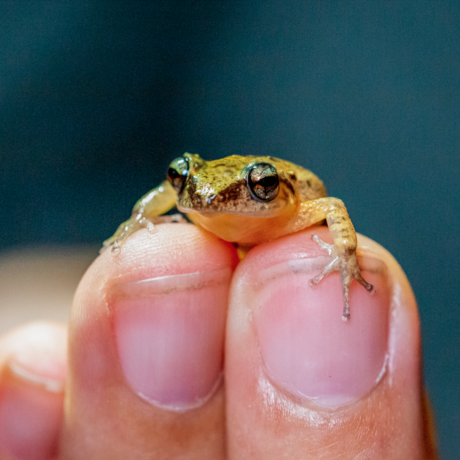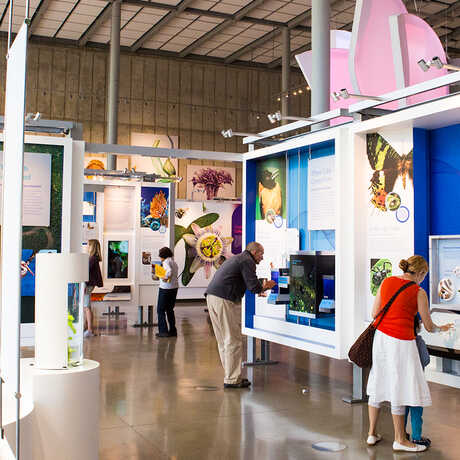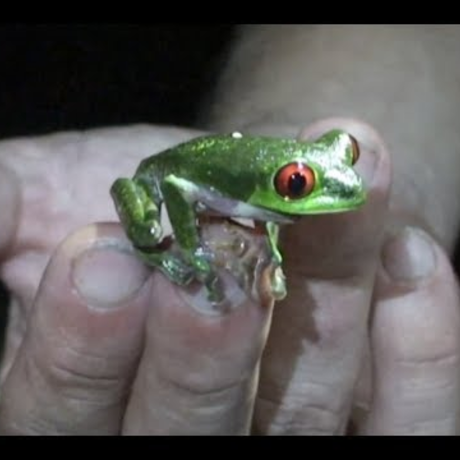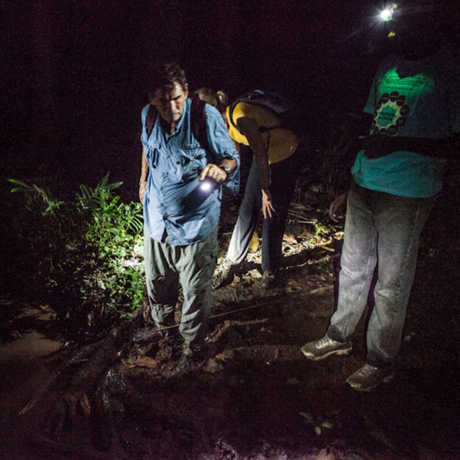Scientist Spotlight
Rayna Bell
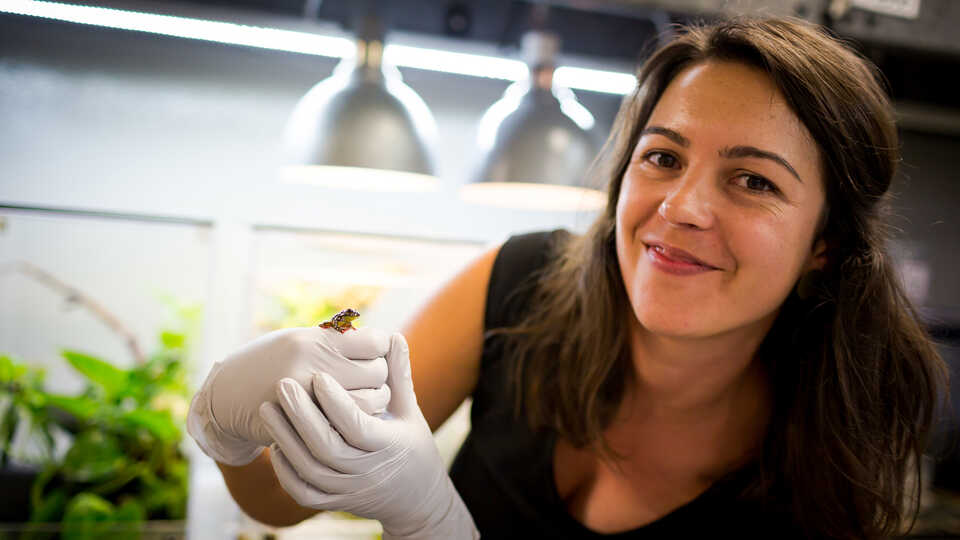
Rayna Bell, PhD, Assistant Curator of Herpetology, joined the Academy in September 2019. She studies the evolution, ecology, and visual systems of tropical frog species.
The highlights of low light
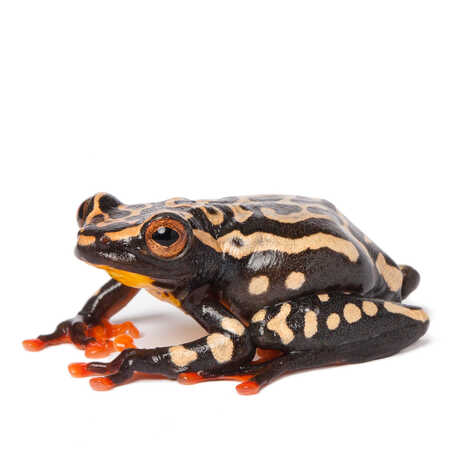
“Most frog biologists do everything in the dark,” says Rayna Bell. This is more of a necessity than a preference, thanks to the nocturnal dispositions of the amphibians she studies. Whether she’s plunging into a rainforest in West-Central Africa guided by headlamp or examining frog retinas in the darkness of her lab, Bell is undeterred by lack of light—which can lead to some illuminating observations.
“It changes the way you look at things when you're walking through the dense rainforest and can only see a meter or two in front of you; you notice tiny creatures and cool-looking plants and fungi you might miss during the day,” Bell says. “I’ve seen bioluminescent fungi ‘by accident’ because I had to turn my light off and wait for a frog to start calling again—and in the darkness I saw the forest floor was glowing. It was pretty magical.”
Above: A Riggenbach's reed frog (Hyperolius riggenbachi)—see it on exhibit in Color of Life.
Early inspiration at the Academy
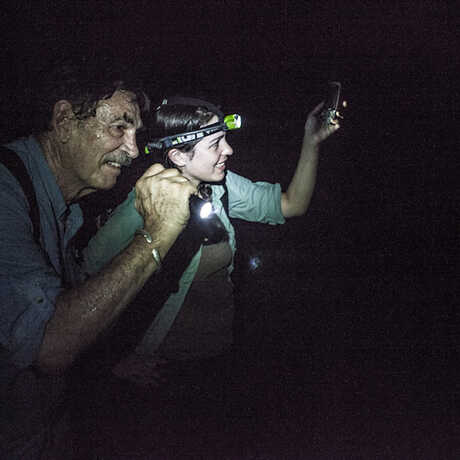
Growing up in Marin County, Bell cherished her annual school field trips to the Academy, letting her imagination run wild in African Hall among the dioramas of impalas, cheetahs, and zebras. While studying Integrative Biology at UC Berkeley, she took a student research position at its Museum of Vertebrate Zoology and was introduced to the Academy’s then-Curator of Herpetology, Bob Drewes. “Within 10 minutes, he invited me on expedition to São Tomé!” Bell recalls. While she had to decline that initial invitation, she did incorporate the Academy’s extensive São Tomé collections into her research while pursuing her doctorate in Ecology and Evolutionary Biology at Cornell University, and has since visited the islands several times with Drewes.
“One winter at Cornell convinced me that fieldwork in the tropics was necessary,” says Bell, wryly. And after venturing to West-Central Africa nine times over the course of her graduate research, she clearly found the antidote to frigid Upstate New York—along with something much more important: The evolutionary mysteries of frogs.
Above: Bell and Bob Drewes on a night expedition in São Tomé. Photo by Andrew Stanbridge.
Island-hopping
When it comes to frogs, there are far more questions than answers—which is what intrigued Bell in the first place. “What’s really exciting for me is how much we don’t know about amphibians, from courtship behavior, parental care, and reproductive strategies, to understanding how they see color,” says Bell. While chytridiomycota, the deadly fungi that are wiping out frog populations worldwide, are understandably getting the lion’s share of global attention, Bell believes that continuing basic research into frog biology, evolution, and distributions—not to mention discovering new species—are central to the global fight against amphibian extinction.
Ground zero for Bell’s research is an ancient archipelago off Central Africa’s Atlantic coast. The Gulf of Guinea islands, consisting of the nation of São Tomé and Príncipe and Equatorial Guinea’s Bioko and Annobón Islands, are living laboratories of species diversity and endemism (species unique to a specific region or habitat and found nowhere else on Earth), and are the perfect ecosystems in which to find answers to fundamental frog evolution and conservation questions.
If the Gulf of Guinea islands are Africa’s answer to the Galápagos, then the African reed frog (Hyperolius spp.) might just be its Darwin’s finch. From variations in body size and color to sexual dichromatism (the difference in coloration between the sexes) and specialized reproduction, Bell has a hunch that the diversity within Gulf of Guinea reed frogs might be directly related to the islands’ unique biogeography and that additional field research and genetic analyses could help explain how these frogs evolved traits like bright coloration and gigantism.
Preserving species diversity
Bell is also exploring a crucial piece of the reed frog’s genetic puzzle that has substantial conservation implications: How, why, and where species hybridize. As habitat becomes increasingly fragmented and altered due to agriculture, urban sprawl, and climate change, worlds increasingly collide for different species of frogs and for other organisms, too. In these “contact zones” where once-isolated species intermix, the scarcer species often lose out. “I’ll continue to track genetic and phenotypic variation across contact zones to quantify the extent of intermixing and potential consequences of hybridization,” says Bell. “By understanding how habitat alteration affects frogs’ reproductive patterns, we can better focus resources on the species that need the most protection.”
For a group that sports such a technicolor spectrum of coloration, we know surprisingly little about how well frogs actually see that coloration—which is why Bell often has the lights out in her lab. As she surveys the rods and cones in the retinal tissues of representative species across the frog tree of life, she hopes to get a clearer sense of the diversity of their visual systems, and how these systems have adapted according to different species’ lifestyles. For example, how does vision differ in a nocturnal, red-eyed treefrog relative to a diurnal poison dart frog or beady-eyed Mexican burrowing frog?
Research globally, sequence locally
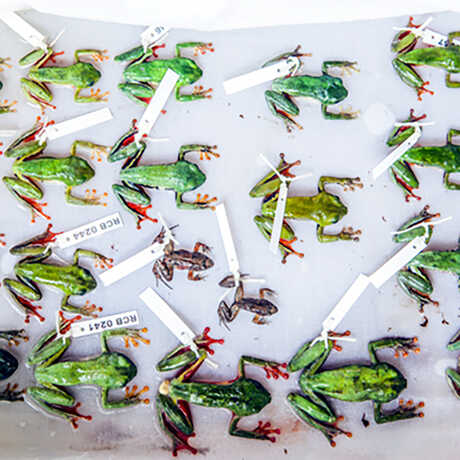
While the scope of her research spans continents, Bell is thrilled to be based in the Bay Area. “The Academy is so unique because it blends field and specimen-based research with the latest genomic and imaging techniques. It’s also exciting to be at a place where our data is easily accessible to the larger research community and where researchers can share their latest results with museum visitors.”
Bell’s spirit of inclusion extends to the field as well: She often invites local residents living near her research sites to join her as research assistants, and is honored to help cultivate the next generation of amphibian ambassadors. Bob Drewes, her mentor who didn’t hesitate to invite her on an expedition 10 minutes after their first meeting, would approve.
Above: Dramatic color and size variation among reed frog specimens collected by Bell during a 2012 expedition to the Gulf of Guinea islands. Photo by Andrew Stanbridge.
Curator Q & A
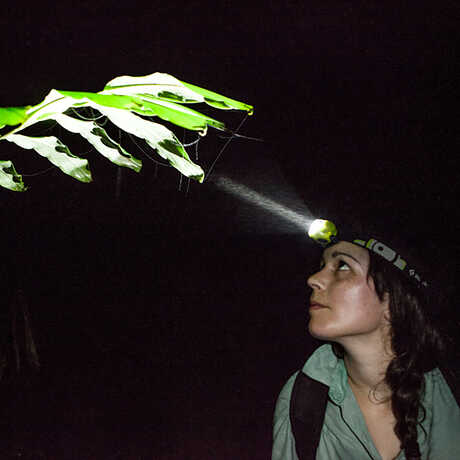
Who is your science hero?
Annie Alexander. She’s the founder of the MVZ [Museum of Vertebrate Zoology] at UC Berkeley, where I first learned about field biology. I would not be here without the MVZ, and the MVZ would not be here without Annie Alexander!
What species would you love to see on exhibit?
The African hairy frog. The males have this bizarre fringe made of skin that looks kind of like hair, and its function is still a mystery. They also have retractable claws that are so sharp that once a large adult male tore through a bag I had placed him in!
What’s your favorite frog call?
The desert rain frog makes the cutest squeaking noise, but it’s worth mentioning that frogs aren’t the only amphibian to vocalize: The Pacific giant salamander barks.
Any words of advice for future scientists?
'Remember: This is supposed to be fun!' That’s what my undergraduate advisor Craig Moritz told me one time when I was having a rough day in the lab. Whenever I feel like those words don't ring true, I try to take a step back and identify what is bumming me out so I can figure out what I need to do differently so I can enjoy what I’m doing.
Department: Herpetology
Title: Assistant Curator of Herpetology, Patterson Scholar
Learn more:
Bell Lab
Twitter profile
Frog call recordings
Vision in Frogs and Toads (ebook available only on Apple devices)



